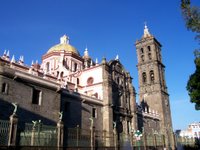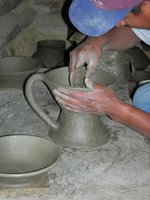My Last Week in Oaxaca
I am writing this entry in the safety of my own home back in Waukegan. I should start by saying my time in Oaxaca was absolutely wonderful. I learned so much by living in the city for two months. I had the opportunity to really get to know the area, the people and the culture. I was also there long enough to experience and form opinions about the marches, protests and violence that have had a profound impact on the way the people of Oaxaca are currently living.
I have never seen the Oaxaca so many people talk about with great fondness and nostalgia. When I arrived, the city was covered in graffiti and the APPO (Asemblea Popular de los Pueblos de Oaxaca) along with the teacher's union had taken up residence in the centro, particularly in the zocalo area. Initially, I didn't feel very affected by their presence, aside from the occasional inconvenience they created as I tried to pass through the city going about my daily routine. Though a number of stores, cafes and restaurants had permanently closed by the time I arrived, I was still able to enjoy many of the cultural and historical attractions the city has to offer. None of us really ever felt unsafe because all of our Oaxacan parents had reassured us that the APPO was protesting peacefully, which they were for the most part.
Last Sunday, after weeks and weeks of gradual destruction of the city, the federal government decided to send in the Policia Federal Preventiva to take measures to remove the APPO and their supporters from the center in hopes of restoring some kind of peace. However, this caused a great amount of uproar amongst the protestors and my last weekend and majority of last week was spent hiding out in my home on the south side of town because it was too dangerous to leave our neighborhood.
The APPO has not taken kindly to the police presence and as a result the supporters of this movement have done everything in their power to make the city virtually unlivable. The picture of the burned bus on the right is just one of seven that were set on fire  and put in the middle of major roads to block traffic from coming in and out of the city.
and put in the middle of major roads to block traffic from coming in and out of the city. The other photo is of the federal police. They are standing in front of one of the street entrances to the zocalo to prevent the APPO from entering. (They physically removed every single protester on Sunday and Monday and have since been gradually removing barricades, graffiti and garbage from the area). The Friday before I left was my very first opportunity to see the kiosk in the zocalo up close. Prior to that day, the AP
The other photo is of the federal police. They are standing in front of one of the street entrances to the zocalo to prevent the APPO from entering. (They physically removed every single protester on Sunday and Monday and have since been gradually removing barricades, graffiti and garbage from the area). The Friday before I left was my very first opportunity to see the kiosk in the zocalo up close. Prior to that day, the AP PO had been using it as their camp ground to display political statements. Now it is the cleanest I have ever seen it.
PO had been using it as their camp ground to display political statements. Now it is the cleanest I have ever seen it.
On Day of the Dead (Thursday), the APPO stayed in one of the universities very close to my neighborhood and the police tried to remove them, which led to a lot of bloodshed and violence. I think what's frightened me most is the manner in which people are fighting. The APPO has taken to creating malatov bombs made from household products, which they hoist at the police with plastic tubes. The police's response to this is to simply pitch them back. The sense of professionalism that we tend to associate with the police or military in the United States is not necessarily the same in Mexico, which terrifies me. As the violence increased that day, the police brought in helicoptors and dropped tear gas into the neighborhood. Fortunately, I was in the center that day meeting with my group when all of this happened and stayed away from the area until my family could safely leave and pick me up. I think that was by far the most upsetting experience I had throughout my stay in Oaxaca. It kills me to see these people destroying such a beautiful, usually peaceful city that relies primarily on tourism to fuel its economy. The tourist market has virtually died as a result of all the protesting and violence that have been going on for over 100 days. However, people are hopeful that things will improve dramatically by December 1. While I was fortunate enough to spend all of my time in Oaxaca (under relatively peaceful circumstances given the political upset), the rest of my group has chosen to relocate to Guanajuato for the duration of their volunteer and class time, which will make for a sad departure from their families and friends, but most importantly a safer living situation.
On a happy note, I am still planning to revisit Oaxaca this January to see how our museum exhibit comes together at Santo Domingo. I received e-mails today from Vero, the secretary of Unión de Museos Comunitarios and Rosie, one of my wonderful project partners. Both assure me that things are still running smoothly and they are anticipating the completion of the exhibit in time for the December 15th deadline, which would be great because we are hopeful that it will draw more people into the artisan communities of Oaxaca, thus helping the local economy.










 had a chance to see or do otherwise. Witnessing a Mexican wedding ceremony and reception was quite an experience. Celebrations are strongly valued here and people enjoy having any excuse to throw a party or festival. To the left is a picture of Marco and me after we´d been dancing for what felt like hours. You can tell we were both kind of tired. After the wedding I retired my dancing shoes for about a week.
had a chance to see or do otherwise. Witnessing a Mexican wedding ceremony and reception was quite an experience. Celebrations are strongly valued here and people enjoy having any excuse to throw a party or festival. To the left is a picture of Marco and me after we´d been dancing for what felt like hours. You can tell we were both kind of tired. After the wedding I retired my dancing shoes for about a week.






